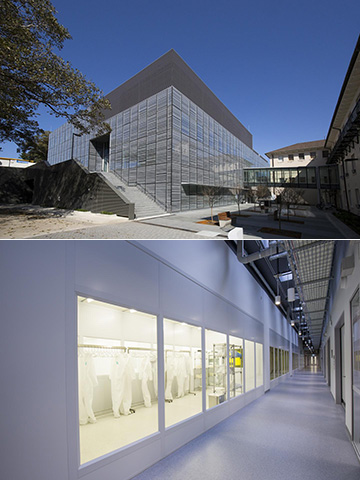
The US$150 million Sydney Nanoscience Hub (top) includes such amenities as state-of-the-art cleanrooms (bottom). [Image: University of Sydney]
On 20 April, the headquarters of the Australian Institute for Nanoscale Science and Technology (AINST), a new government-academic-industry initiative, was officially launched with a two-day scientific and technical meeting at the University of Sydney. Jointly funded by the university and the Australian government’s Commonwealth Education Infrastructure Fund, the headquarters building—a US$150 million state-of-the-art facility dubbed the Sydney Nanoscience Hub—has been billed as “the most advanced facility for nanoscience in the region,” and aims to bolster Australia’s position as a research center in areas such as nanotech-driven biomedicine and quantum computing.
Photonics at the hub
Both the structure of the research organization and the guest list of the opening technical meeting suggest that photonics, and advancing and commercializing photonic applications, will have an important place in the new center. One of the center’s five “flagship programs” involves nanoscale photonic circuits, and is being headed by OSA Fellow and Sydney professor Ben Eggleton, the head of the Australian Research Council’s Center for Ultrahigh-Bandwidth Devices for Optical Systems (CUDOS), based at the university.
Eggleton, whose group works on new approaches to photonic-chip waveguides and techniques to speed up on-chip signal processing, believes that the new facility—which is designed to integrate lab space with state-of-the-art cleanrooms and teaching facilities—will “transform” the way his group performs experimental research. Among the guests at the opening meeting was OSA Fellow and nonlinear-optics researcher Moti Segev of Israel’s Technion, whose team is collaborating with Eggleton’s group on efforts in topological photonics, under an academic-industry funded program.
The new center’s research agenda also includes a healthy dose of solar. Another flagship program aims to leverage nanotechnology to improve battery and energy storage capabilities for renewable energy. And the institute’s list of “foundation projects” includes efforts in nanomaterials research for improved solar cells, and in nanomaterial-based coatings for better energy efficiency and conversion.
Quantum computing
Beyond these areas and a strong additional focus on its biomedical work, much of the early publicity surrounding the new nanotech hub has centered on quantum computing and information processing, the subject of another of AINST’s flagship programs. Particularly noteworthy was the high-profile presence at the opening event of Microsoft, which is devoting increasing research resources to quantum computing. The institute’s foundation projects include efforts on both the electronic and the photonic side in the quest to scale up quantum computing from bench-scale experiments to functional quantum machines.
